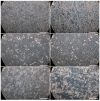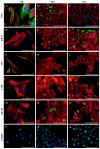Impairment of Intermediate Filament Expression Reveals Impact on Cell Functions Independent from Keratinocyte Transformation
- PMID: 39682709
- PMCID: PMC11640723
- DOI: 10.3390/cells13231960
Impairment of Intermediate Filament Expression Reveals Impact on Cell Functions Independent from Keratinocyte Transformation
Abstract
Although cytoplasmic intermediate filaments (cIFs) are essential for cell physiology, the molecular and cell functional consequences of cIF disturbances are poorly understood. Identifying defaults in cell function-controlled tissue homeostasis and understanding the interrelationship between specific cIFs and distinct cell functions remain key challenges. Using an RNAi-based mechanistic approach, we connected the impairment of cell-inherent cIFs with molecular and cell functional consequences, such as proliferation and differentiation. To investigate cIF disruption consequences in the oral epithelium, different cell transformation stages, originating from alcohol-treated oral gingival keratinocytes, were used. We found that impairment of keratin (KRT) KRT5, KRT14 and vimentin (VIM) affects proliferation and differentiation, and modulates the chromatin status. Furthermore, cIF impairment reduces the expression of nuclear integrity participant lamin B1 and the terminal keratinocyte differentiation marker involucrin (IVL). Conversely, impairment of IVL reduces cIF expression levels, functionally suggesting a regulatory interaction between cIFs and IVL. The findings demonstrate that the impairment of cIFs leads to imbalances in proliferation and differentiation, both of which are essential for tissue homeostasis. Thus, targeted impairment of cIFs appears promising to investigate the functional role of cIFs on cell-dependent tissue physiology at the molecular level and identifies putative interactions of cIFs with epithelial differentiation.
Keywords: apoptosis; chromatin; differentiation; intermediate filaments; involucrin; keratin; keratinocytes; proliferation; transformation; vimentin.
Conflict of interest statement
The authors declare no conflicts of interest.
Figures





Similar articles
-
Mesenchymal stem cells differentiate into keratinocytes and express epidermal kallikreins: Towards an in vitro model of human epidermis.J Cell Biochem. 2019 Aug;120(8):13141-13155. doi: 10.1002/jcb.28589. Epub 2019 Mar 19. J Cell Biochem. 2019. PMID: 30891818
-
Cytoplasmic intermediate filaments are stably associated with nuclear matrices and potentially modulate their DNA-binding function.DNA Cell Biol. 2002 Mar;21(3):213-39. doi: 10.1089/10445490252925459. DNA Cell Biol. 2002. PMID: 12015898
-
Internal epithelia in Drosophila display rudimentary competence to form cytoplasmic networks of transgenic human vimentin.FASEB J. 2017 Dec;31(12):5332-5341. doi: 10.1096/fj.201700332R. Epub 2017 Aug 4. FASEB J. 2017. PMID: 28778974
-
Keratins as an Inflammation Trigger Point in Epidermolysis Bullosa Simplex.Int J Mol Sci. 2021 Nov 18;22(22):12446. doi: 10.3390/ijms222212446. Int J Mol Sci. 2021. PMID: 34830328 Free PMC article. Review.
-
Lamins: The backbone of the nucleocytoskeleton interface.Curr Opin Cell Biol. 2024 Feb;86:102313. doi: 10.1016/j.ceb.2023.102313. Epub 2024 Jan 22. Curr Opin Cell Biol. 2024. PMID: 38262116 Review.
References
-
- Griswold M.G., Fullman N., Hawley C., Arian N., Zimsen S.R., Tymeson H.D., Venkateswaran V., Tapp A.D., Forouzanfar M.H., Salama J.S. Alcohol use and burden for 195 countries and territories, 1990–2016: A systematic analysis for the Global Burden of Disease Study 2016. Lancet. 2018;392:1015–1035. doi: 10.1016/S0140-6736(18)31310-2. - DOI - PMC - PubMed
-
- Roesch-Ely M., Steinberg T., Bosch F.X., Mussig E., Whitaker N., Wiest T., Kohl A., Komposch G., Tomakidi P. Organotypic co-cultures allow for immortalized human gingival keratinocytes to reconstitute a gingival epithelial phenotype in vitro. Differentiation. 2006;74:622–637. doi: 10.1111/j.1432-0436.2006.00099.x. - DOI - PubMed
Publication types
MeSH terms
Substances
Grants and funding
LinkOut - more resources
Full Text Sources
Research Materials
Miscellaneous

